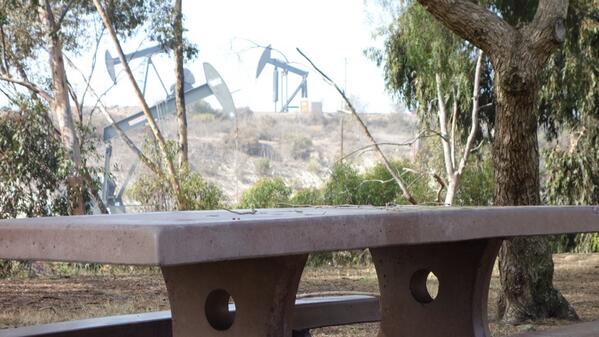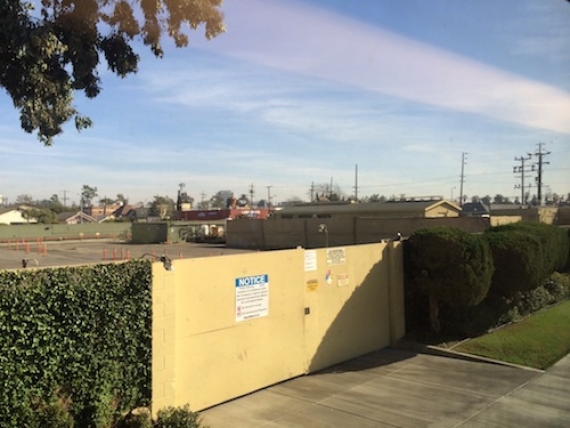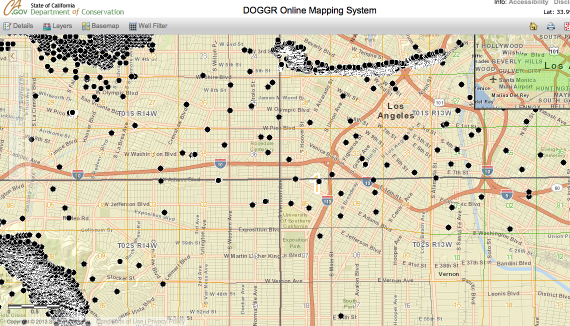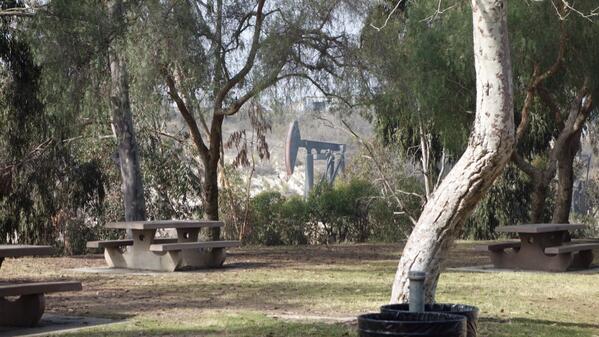This post was authored by HEFN Program Manager Ramtin Arablouei.
California is no stranger to oil drilling. Upton Sinclair’s novel “Oil,” later made into the movie “There Will Be Blood,” captures the fervor of the oil rush of the mid-1800s. People in Southern California are accustomed to the sight of oil derricks in the distance, slowly pounding away against dusty fields. This may help explain why it is hard for many Angelenos to understand that fracking brings new threats to this long history.
Sitting directly above the Monterey Shale, Los Angeles County is a newly reinvigorated hub of oil drilling made possible by the advancement of horizontal fracking. It is one of the latest frontiers in a nationwide expansion of the controversial drilling technique.
On January 25th, the Liberty Hill Foundation, 11th Hour Project, and Health and Environmental Funders Network co-sponsored a funder tour of fracking in Los Angeles. Eighteen funders from California and across the country participated in a whirlwind tour of impacted areas organized by Daniela Simunovich and Michele Prichard from Liberty Hill Foundation and guided by members of the community.
We visited the Inglewood oil field where fracking sites have consumed a large part of Kenneth Hahn State Park (see image below). Several sections of the bordering Baldwin Hills neighborhood have active wells just a few feet from residential housing. The landscape is dotted with oil rigs, with many more proposed for the next few years. In one neighborhood, nearly 10 schools surround a large fracking site. No buffer zones were allotted for residents. In fact, one oil company built housing for university students directly adjacent to a fracking well pad, effectively eliminating the buffer zone between residents and drilling activity.

A picnic bench in Baldwins Hills State Recreation Area sits adjacent to a oil drilling dite. Image source: Farhad Ebrahimi via @Yahktoe.
(Image source: Farhad Ebrahimi via @Yahktoe.)
The tour continued to the West Adams/Jefferson Park in South LA. There, two well sites connected by underground drilling sit in the middle of one of the most densely packed areas of California. One advocate recounted an accident at one fracking site that sent crude oil spraying into the neighborhood. A local resident who was riding his bike home was covered in oil as he passed the facility. The site manager called the incident a “misting.”
The proximity to residential areas has raised concerns from local residents about their water and air quality. Anecdotal evidence suggests an uptick in respiratory illnesses and incidence of cancer. Complaints to local regulatory agencies have been met with skepticism. Advocates kept pointing out the need to effectively document the current and potential impacts of drilling on public health in the region. We also learned on the tour about drillers’ uses of “acidization” techniques that inject hydrofluoric or hydrochloric acid into wells, raising additional concerns about water contamination.

A residential area surrounds the Murphy drill site in South Los Angeles.
(Image source: Ramtin Arablouei.)
Southern California’s history as an oil producing region might be working against the communities impacted by fracking. According to some advocates on the tour, the legacy of drilling in the state has made the legal process efficient for companies seeking to open previously capped wells or to develop new drilling sites. Challenging or monitoring these permits is difficult and time consuming for concerned citizens. Many community organizations do not have the legal capacity to challenge these permits. As a result, fracking wells are being developed in Los Angeles county at an alarming rate (see map). Advocates on the tour expressed the need for legal support to address permitting, enforcement, and other avenues of protecting communities.

A screenshot of California’s Department of Conservation’s map of oil wells around Los Angeles. Each black dot represents an oil well.
(Image source: California Department of Conservation’s DOGGR Online Mapping System.)
Fracking is now a reality in many communities across the country. From North Dakota to Pennsylvania, and now to California, scientists, organizers, and advocates are shining a light on the environmental and public health impacts of all phases of fracking. Each state and region has its own unique variables, yet the impacts are familiar. Los Angeles is the second most populous metropolitan area in the country. Many funders pointed out that it is the first US city of this kind to experience widespread fracking.
I found the sights, sounds, and smell virtually unbearable at times as we witnessed the noise of drilling, truck traffic in and out of sites, and the lingering, acrid odor that fills the air. Imagine an oil rig blocks away from a soccer field, or crude oil spraying out of a well pad and onto homes in an overcrowded neighborhood. This is life for the people of Culver City, Baldwin Hills, Long Beach, Wilmington, and many other parts of the greater Los Angeles area.
California has become another key state where the debate over the impacts of fracking will rage on (see here and here). Is it good for the California’s battered economy? How severe are the impacts on the environment and health? From Sacramento to local city councils these discussions continue as fracking expands. Currently, California reminds us that even in the birthplace of some of the most stringent environmental and health regulations, the fossil fuel boom trumps protection for the public.
After a full day of hopping from one site to another many funders expressed the feeling that they were witnessing an experiment unfold in one of the most influential parts of the country. Funders are planning on continuing the conversation about how they can be most helpful to the work happening on the ground. The work will continue as the fracking continues to be a central issue in the United State’s energy future. And we should all be paying attention.
HEFN’s working group for funders concerned about impacts of fracking continues to raise awareness and organize around the issue in philanthropy. We welcome funders to contribute to our ongoing conversation. For more information, visit HEFN’s resources on fracking or email rarablouei@hefn.org.

